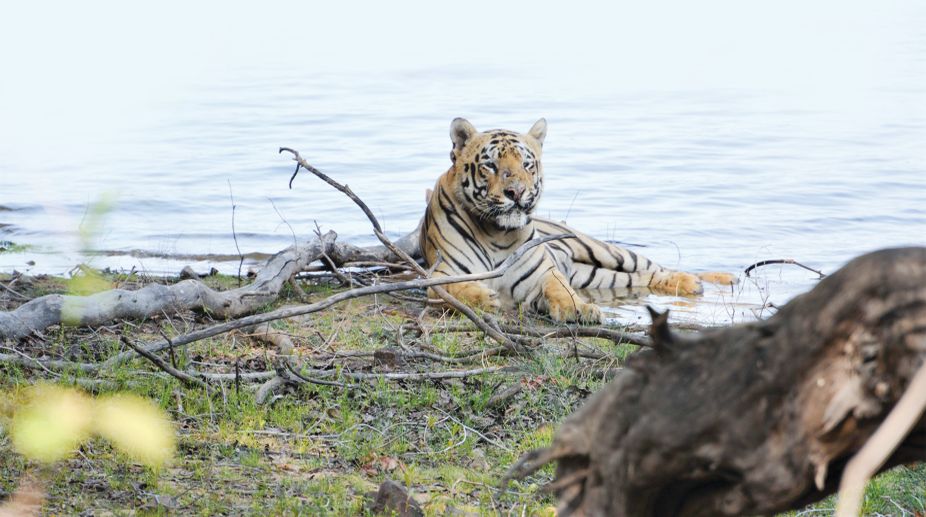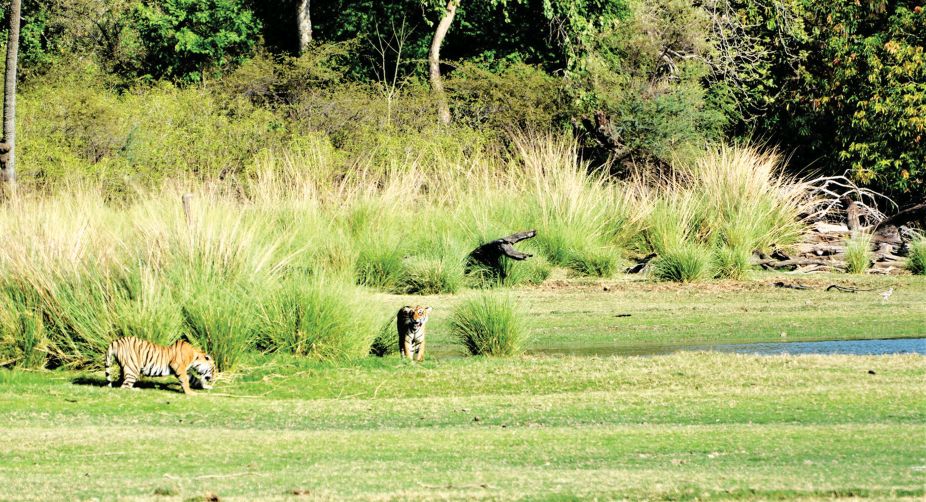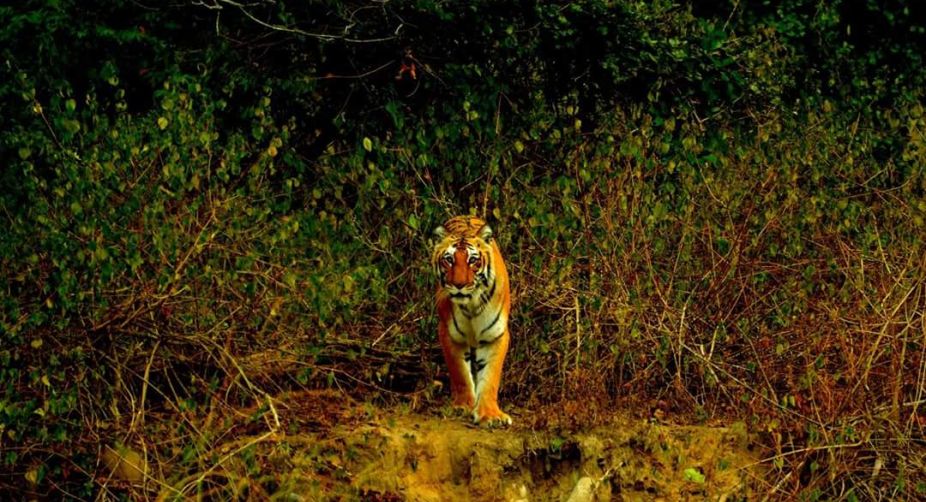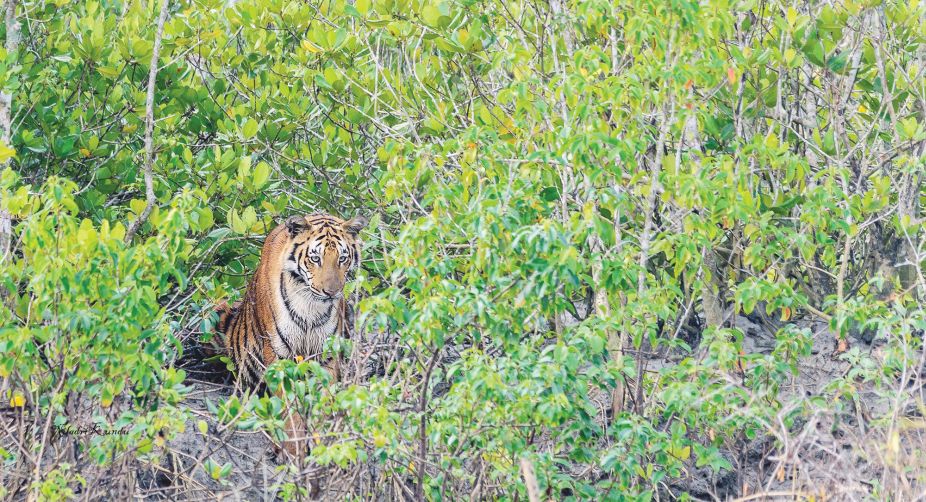BSF intercepts Bangladeshi woman crossing border
Amid rising tensions in Bangladesh, reports suggest that some individuals are attempting to cross the India-Bangladesh border illegally, seeking to settle in India.
There shouldn’t be any difference of opinion regarding the need for conserving this apex predator since India is home to 70 per cent of the world’s tiger population.

Tiger resting at Tadoba Lake during summer, Central india
‘Katrina or Priyanka? ’A colleague interrupted our thoughts as we discussed our Kaziranga trip. He wanted to know the name of the tiger we had seen at Kaziranga. But tigers at Kaziranga don’t have names, unlike those in Northwestern and Central Indian forests (some name instances are there in South India too).
Over the course of our journey into Indian wilderness, we have realised some subtle variations in the tigers that reside across different forests just like the naming convention.
There is a collective behaviour of tigers depending on the forests which has imposed itself on the distinct personality of an individual — tigers from Ranthambhore and Central India are different from those in Corbett whereas Sundarban tigers are unique from the rest.
Advertisement
Tiger science – genetic identification
India is home to the Bengal Tiger, one of the five subspecies of tiger currently found in the wild. Within this subspecies, research report (“Conservation priorities for endangered Indian Tigers through a genomic lens.”: Meghana Natesh, Uma Radhakrishnan; Scientific Reports 7, Article Number: 9614 (2017)) has identified three genetically distinct clusters corresponding to northwest, southern and central India.
The first cluster, designated as the North West cluster, is solely composed of individuals from a single protected area in the northwest region – Ranthambore. The second cluster is the largest of the three comprising tigers from North, North-East, East and Central India with the third cluster, belong to those from southern India.
There are other research reports like Status of Tigers in India 2014. National Tiger Conservation Authority, New Delhi and The Wildlife Institute of India, Dehradun (2015) by Jhala, YV, Qureshi, Q and Gopal, R (eds) which indicate that North-Western tigers may form a distinct genetic cluster compared to those from Central India.
Similarly, it is believed that Sunderbans tigers were originally a part of a contiguous region with others and was perhaps separated about 500 to 1000 years ago. They are in fact an isolated population of Central Indian Tigers.
Beyond genes, there are subtle yet distinct behavioural traits too that manifest themselves among the tigers from different forests and habitats.
Central India – Land of legends
Central India has some of the best-known forests in India with the abundant presence of tigers and other wild species. Tigers here are known by names — some of the past and present tigers like Sita, Charger, Munna, Collarwali, Maya have all emerged from here.
They all have one thing common — they are bold, indifferent at times to the numerous clicks of the tourist cameras and offer plenty of time to the observers. Tigers like Collarwali and Maya even come out with their cubs and walk straight past the waiting gypsy carrying tourists.
In Central India, the dry deciduous forest cover is gradually depleted during summer and the tigers have little options but to venture out on the open. The water sources become rare and whatever are available, the tigers come either to drink or cool off by submerging themselves with their backs in the water.
Tigers here rarely swim across the lakes however there is a continuous struggle among them to keep hold of the prime habitats near the lakes where prey is abundant. Sonam drove away her mother Madhuri and her own sisters from Telia lake in Tadoba.
Tigers in Central India are found to travel significant distances within and outside reserve — there are numerous examples of tigers moving among Kanha, Pench Bandhavgarh forest corridors.
In an era where genetics variation is at its lowest, these travels are critical allowing mixing of genes, which in turn may pave the way for a future healthy tiger population.
Ranthambhore -the Lake Tigers
Ranthambhore presents picturesque Jogi Mahal overlooking a prime habitat of Rajbagh Lake – an estate that has been the bone of contention among tigers here starting from the days of Machli, Queen of Lakes.
The last two decades have witnessed continuous fights among her descendants over the area. Krishna, Machli’s daughter from her fourth litter, rules here but is soon to be challenged by Arrowhead, her daughter.

Ranthambore too like Central India has produced tiger icons with Machli leading from the front and her legacy lives on beyond the boundaries up to Sariska.
It is probably here that naming of tigers started in Indian forests that came to be adopted elsewhere — in 1976 or so Fateh (the then Field Director of Ranthambore) had named a mother tigress as Padmini while observing her for hours with her cubs.
Like Central India here also forest cover is dry and consequently tigers are not shy to come out, sometimes even using cover of gypsies to hunt .With lakes like Padma Talao, Malik Talao being prime sources of water and prey during long summer months, tigers are found to cool themselves in the water similar to what we observe in Central India.
However, one notable difference is that tigers here have adapted themselves to chase and hunt prey in the lake waters —this is evident through stories of tigers like Chengis who specialised in hunting in the lakes. Even the presence of crocodiles has failed to deter the tigers from their hunts.
Machli even killed a crocodile which made her famous across the world and there are other instances of tigers attacking crocodile as evident from accounts of Valmik Thapar and Fateh who studied them for many years.
However, over the course of time Ranathambhore tigers have gradually become isolated — the inbreeding through generations may pose future threat of extinction as feared by the scientists. Corridors could be a potential solution to connect Ranthambhore with Central India but we have to wait and see how it shapes up in future.
Corbett- the Himalayan Tiger
The first glimpse of Corbett National Park instills a feeling of fulfilment given the dense forest cover and undergrowth with mighty Shivaliks as backdrop. Open riverbeds with pebbles, sal canopies present visuals that no forests can offer in India.

These terrains have made Corbett tigers shy and elusive, quite uncomfortable in presence of humans unlike the Central and Western Indian cousins where forest cover remains thin for a large part of the year.
Jim Corbett made this place popular through his accounts of hunting man-eaters and even today the tigers are kind of looked upon as ones carrying that legacy! Having said that, of late in the last few years there are tigers are popular and have shed their “shy” tag.
Tigresses like Paro, Sharmilee (aka Bijrani Queen) have given enough time to tiger enthusiasts to know and photograph them. Their initial hesitation is gone and like Maya or Collarwali, they too walk past the gypsies now — sometimes with kills! Still most tigers are unknown when compared to Central India or Ranthambore proving their elusive nature.
We could sense this when a big cat crossed our path and disappeared fast — it didn’t stop or move with us. Had it been Central India or Ranthambore , it would have surely glanced at us or would have walked with us on the road.
Corbett tigers are often found swimming through the Ramganga river (that flows through the park) or cooling themselves in the waters. There are no crocodiles here but then there are elephants which do pose a challenge to the tigers.
However, very rarely tigers attack elephants as they move in herds. Jim Corbett had described the famous encounter when two tigers killed an adult elephant but over the years they have learnt to co-exist in Corbett.
Sunderbans- the Mangrove Tigers
Genetically defined as related to tigers in Central India, Sunderban tigers are considered to be different from rest of India. The name “Royal Bengal Tiger” owes its origin probably to the Sunderban tigers when one of them killed a member of the British royal family.
There is an aura of mystery around the tigers here — they are the only ones who live in the mangrove forests in India. People who live here near the forests respect the tigers.
Every time we speak to someone from Sunderbans, we come to know about tiger attacks on humans — it is like a ghost that appears from nowhere, gets hold of its prey from the boat or on the mud banks and disappears in the forests.

There is a general belief that Sunderban tigers are habitual man-eaters unlike those in other parts of India where man-eating instances are rare. Human casualties remain far more than those in other forests in India and this is what makes Sunderban tigers to be feared and revered at the same time.
Some people attribute this to excessive salinity of the water that tigers drink making them irritable but these remain largely inconclusive. As per M. Moninul Khan (wildlife biologist working on tigers and other wild animals of Bangladesh) — “In the absence of concrete evidence to prove any theory, however, it might be better to conclude that the man-eating habit is simply a behavioural character of some tigers in the Sunderbans”.
Tigers here are expert swimmers — they brave the high and low tides in their constant struggle in these swamp forests day in and day out. They remain elusive -usually spotted in the mangrove forests or along the banks walking stealthily on the mud flats.
There is no challenger to the tiger — they are truly the king and literally worshipped in this part of the country. Hence his name is Dakhin Roy or the Tiger God — only name used to identify all the Sunderban tigers.
Our journey of exploring tiger reserves started with the sole ambition of spotting tiger in the wild .The ambition transformed into a never ending attraction when we first saw a tiger in the forest for a few seconds.
As we kept exploring, we understood the importance of different forest habitats which apart from being unique are an absolute necessity to protect the Bengal Tiger sub species in the long run.
While tiger behaviour differs but in the year when a subcontinent wise census for Bengal Tiger is underway, there shouldn’t be any difference in opinion regarding the need for conserving this apex predator (India being home to 70 percent of the world’s tiger population).
As legendary Jim Corbett observed, “The tiger is a large-hearted gentleman with boundless courage and that when he is exterminated-as exterminated he will be unless public opinion rallies to his support-India will be the poorer, having lost the finest of her fauna”.
Advertisement